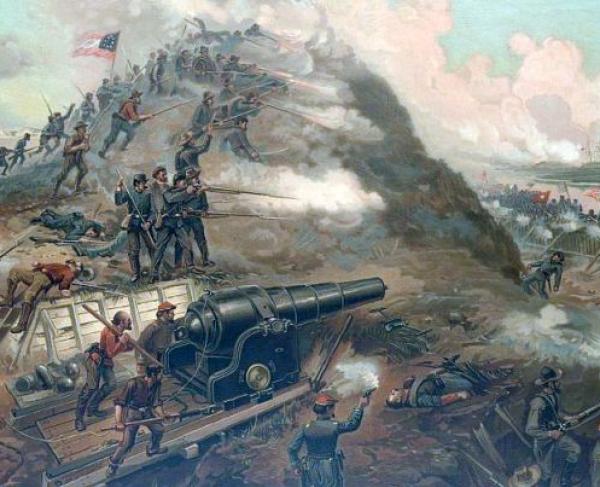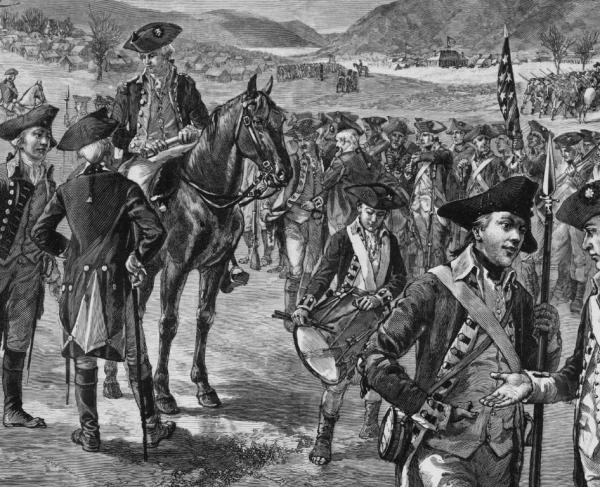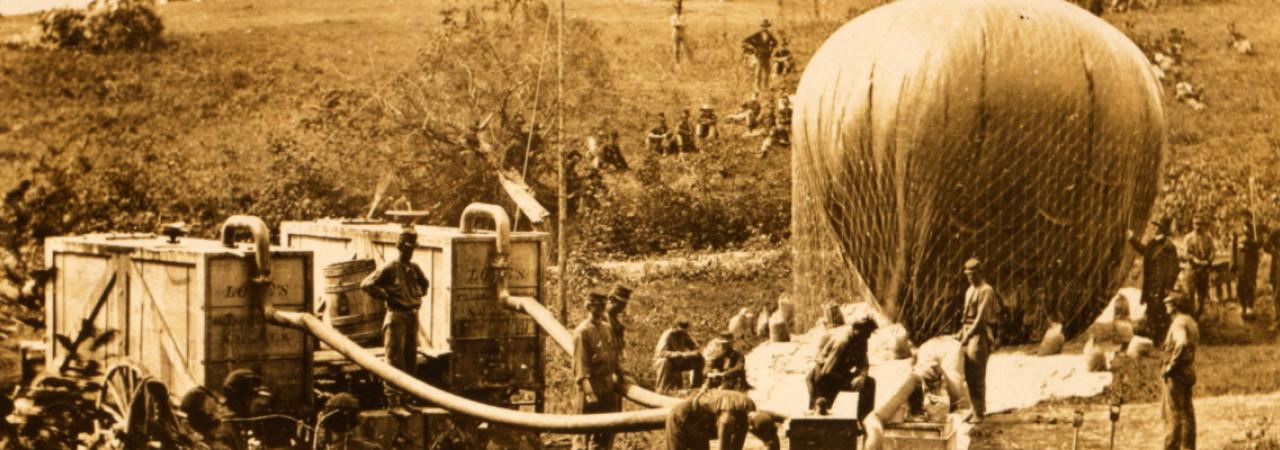
Were balloons used by world militaries before the American Civil War?
The French Committee of Public Safety created a Corp d’Aerostiers in 1794. Intended to conduct aerial reconnaissance, the balloons first went into action during the battles of Charleroi and Fleurus later that year. The Corps remained in service until it was disbanded during the Egyptian campaign. Lowe’s Aeronautic Corps was the second major international experiment in airborne battlefield reconnaissance.
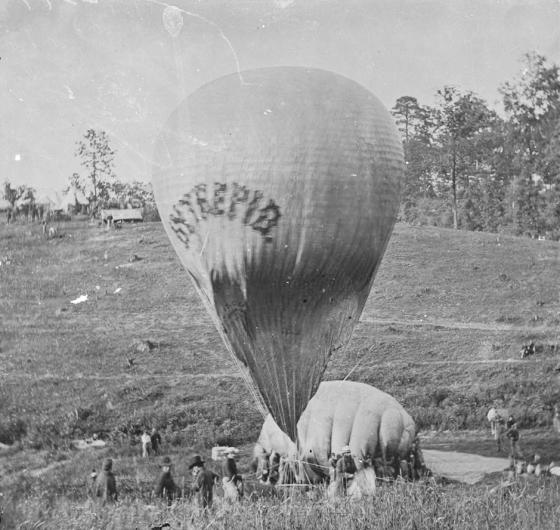
What roles did balloons play during the Civil War?
The balloons and aeronauts conducted aerial reconnaissance and artillery spotting. With an ability to soar a thousand feet above the landscape, balloons gave military leaders a platform that allowed them to see for miles around – a decided advantage, especially in areas with little topography. During the Seven Days Campaign in 1862, Union balloons stationed at the Gaines’ Farm could observe movement within downtown Richmond, which was roughly seven miles away.
Did both sides use balloons during the Civil War?
Both sides used balloons, although the Union aeronautical program was far more successful and better organized.
Were the balloons used in the Civil War purpose-built for military use?
Thaddeus Lowe designed especially tough balloons for use with the army. They were constructed of more durable material than those flown by civilian aeronauts.
Did they use balloons in both the eastern and western theaters of the Civil War?
Balloons were used in the eastern theatre, to some extent on the western rivers and along the southern coast. Union balloons were employed around Washington DC and Manassas in 1861, used extensively during the 1862 Peninsula Campaign, and employed during the Fredericksburg and Chancellorsville campaigns. In the western theater, balloons were used to support the campaign against Island Number 10 in the Mississippi River. Confederate balloons were employed around Richmond during the Seven Days Campaign.
How big were Civil War balloons? How many people could they carry?
The largest balloons (Union and Intrepid) had a capacity of 32,000 cubic feet of lifting gas and could carry 5 people aloft. Constitution and United States had 25,000 cubic foot envelopes and could carry up to three people. Washington had a 20,000 cubic foot bag and could carry two people aloft. With a capacity of 15,000 cubic feet each, Eagle and Excelsior were one man craft.
Smaller balloons could be inflated and sent skywards in a shorter amount of time. Larger balloons carried more observers and could include telegraphers and their gear.
What did they inflate Civil War balloons with? And how did they inflate balloons out in the field?
Balloons were normally inflated with city gas when it was available, as in Washington and Richmond. In the field, Thaddeus Lowe designed and the Navy Yard constructed special inflation wagons. Charged with dilute sulfuric acid and iron filings, they generated hydrogen. These portable gas generation wagons gave the Union balloonists the ability to deploy more freely in the field.
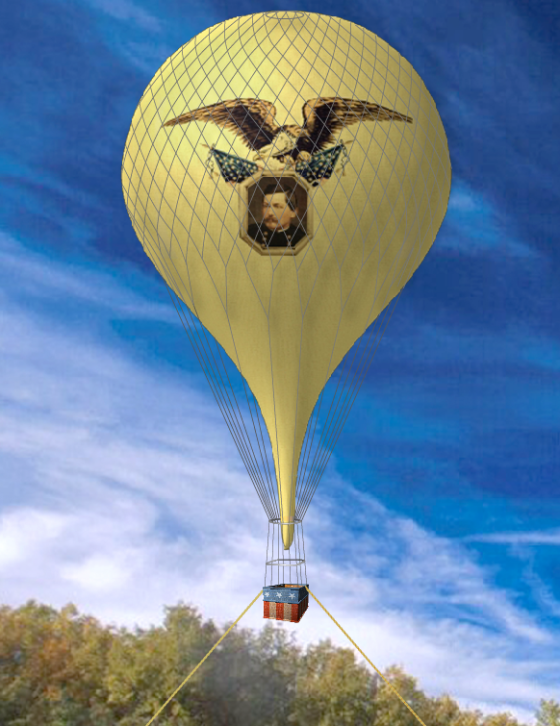
Could Civil War balloons fly independently or were they tied to the ground?
With the exception of some John La Mountain flights, Civil War balloons were always intended to be tethered to the ground. There were accidents, however, as in the famous flight of Fitz John Porter over the Confederate lines and back again.
Why did Union balloons employ such colorful designs? Weren’t they afraid of being shot at?
Lowe was a born showman. In addition, he may have thought that the sight of a balloon watching over them would disconcert the Confederates.
Was a Civil War balloon ever shot down while in flight?
No. There are recorded attempts by Confederate artillerists to destroy balloons on or near the ground, but all of those attempts failed. Positioned well behind the front lines, and at an altitude of near 1,000 feet, balloons were difficult, if not impossible, targets for opposing militaries.
Were any photographs taken from balloons during the war?
Not that we know of, which is a bit strange because photographs of both Paris and Boston were taken from balloons before the war.
How did Civil War balloonists transmit their observations to their high commands?
By telegraph or signal flags. Lowe had developed his own signal system which was not implemented. The larger Union balloons could carry telegraphers and their gear in the basket, thus speeding along information derived from aerial observations.
Did the navies on either side employ balloons?

Yes. During the fighting at Island Number 10, John Steiner directed naval gunfire against masked Confederate targets while flying tethered to a vessel.
Both sides utilized naval vessels to help transport and support balloon operations during the war. Naval vessels greatly improved the ability to move and support cumbersome balloons in theaters that had navigable coasts and rivers. The George Washington Parke Custis, a converted coal barge, was used by the Union army as an early aircraft carrier. And the CSS Teaser was used by Confederate forces to deploy balloons on the James River. On July 4, 1862 the CSS Teaser ran aground in the James and it and its balloon were captured by the USS Maratanza.
Did the senior military leaders value balloons?
After witnessing a balloon demonstration near the White House in 1861, Abraham Lincoln became an active proponent of using balloons to assist the war effort. Maj. Gen. George McClellan greatly valued the intelligence derived from aerial observation and many senior Federal officers, including McClellan, Fitz John Porter, John Sedgwick, Baldy Smith, John Reynolds, Joe Hooker, and George Custer made ascents in balloons.
Famed Confederate artillerist Edward Porter Alexander made a number of ascents in the Confederate balloon Gazelle during the Seven Days Campaign. Ordered by Robert E. Lee to observe Union movements in the theater, Alexander would later write that “skilled observers in balloons could give information of priceless value.” He also described the Union decision to abandon military ballooning as a “decided mistake.”
If balloons were so valuable, why did the Union army stop using them during the war?
This is a complicated question. A variety of factors led to the abandonment of the balloon corps in 1863. As a civilian, Lowe had a difficult time integrating his operation into Army bureaucracy. Lowe, while politically astute and conscious of the need for good public relations, had a difficult time with the officers overseeing his operation. The communication of balloon intelligence to a commander engaged in battle was sometimes difficult. The Corps faced difficult logistical problems that sometimes prevented it from moving as quickly as desired.
Is it true that Ferdinand von Zeppelin came to America to observe Civil War balloons in operation?
No, he did not come to the U.S. to observe balloon operations. He served with Federal cavalry units in Northern Virginia. At the end of his visit, he wanted to see some more of the country. He traveled to New York City, up the Hudson, across the state on the Erie Canal, across the Great Lakes and out into Minnesota, where he met John Steiner, one of Lowe’s aeronauts, who had returned to his pre-war profession as an exhibition balloonist. Zeppelin flew with him and listened to his dreams of a navigable airship. Many years later the Count explained that the experience with Steiner had marked the beginning of his own interest in flight.
Learn More: Thaddeus Lowe

